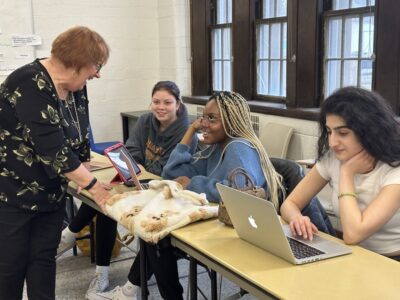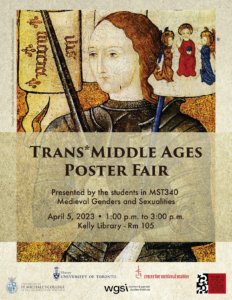The Trans* Middle Ages Poster Fair taking place at the University of St. Michael’s College in early April aims to shed light on the rich and diverse experiences of trans people during the mediaeval period.

The goal, says Dr. Jacqueline Murray, who teaches the course Medieval Genders and Sexualities as part of the Mediaeval Studies Program at St. Michael’s, is not only to further inquiry into a historical area that has only recently gained traction but also to foster empathy and a greater ability to see the dignity inherent in all people.
“People think the trans experience is a modern phenomenon but as these posters will demonstrate this is not a new thing,” Murray says. “This course offers an inclusive understanding that there are – and have always been – many ways individuals experience and live their identity.”
The poster fair, which is the capstone project in Murray’s class, will see students working in teams to produce posters on a specific person, including many saints, offering evidence of a trans experience.
There are many benefits to students participating in a poster presentation, she says, because they engage in significant historical research to find the information they will display on the posters, and then develop creative ways to display that research to engage the visitors to the fair. Because this is a team project, students demonstrate their ability to work collaboratively. And when the posters are displayed at the fair, students will engage with attendees who have questions about their presentations.
All of the skills students develop in the creation of their poster are transferable, she adds, regardless of whether participants are moving on to further studies or into the workforce.

The work involved in preparing for the Trans* Middle Ages Poster Fair offers the added learning experience of tackling a research area that is just beginning to open up, demonstrating to our present society the importance of the past to understanding current human experience. The deliberate use of Trans* in the event’s title is designed to point to the variety of trans experiences, including social presentations of transvestism or drag to nonbinary and genderfluid identities.
“There are mediaeval medical treatises that address the premodern physical and social experiences of intersex people. There is plenty of documentation of women who dressed as men to receive an education,” Murray says, adding that some people who lived their lives as monks were found after death to have been biological women. St Joan of Arc, she adds, is likely one of the best-known people from the Middle Ages whose life suggests a trans experience.
Research into the mediaeval church indicates that it was a far less homogenous time than many assume, Murray explains, and it was not a time when the pope dictated to church members what to do and how to live.
“That is a myth to be dispelled,” she says, arguing that church of the Middle Ages embraced diversities that may surprise many people today.
Dena Abtahi, a 4th-year student majoring in Human Biology and Molecular Biology with a particular interest in medical equity, opted to enroll in the Medieval Genders and Sexualities course because, while she considered herself well educated in other historical eras, she wanted to know more about the Middle Ages, believing it helpful to have a historical understanding of the era to shed light on humanity’s progress as well as ways in which we have regressed. A bonus, she adds, was the opportunity to study with Dr. Murray, who is a leading expert in the field.
“In reading primary sources I was transported back to the era and studying persecution then led me to ask, ‘Is this person still persecuted?,’” she says.
Abtahi says she has learned from reading about the fears people felt at feminine men and masculine women and related issues, such as worries that women might be appropriating social or sexual masculinity.
“Despite obstacles and fears, people who knew they were different and presented differently were fighting for rights, just as women in my home country (Iran) are fighting for their rights regarding the hijab, for example,” she says.
Hilary Packard, a 3rd-year student with a double major in visual studies and mediaeval studies, says the Mediaeval Gender and Sexualities course enhances their minor in critical studies in equity and solidarity.
As someone who does advocacy work for trans people in sports, Packard says the course is intensely timely given, for example, the current movement in many jurisdictions in their native United States to restrict the rights of trans people.
“Trans people are being criminalized but they have been here all along and are part of humanity,” they say.
Packard points out that until recently there was little analysis available to those outside the realm of historians on the experience of women in the Middle Ages. Current work to move more specifically to examine the mediaeval queer experience will be similarly helpful in teaching us about the evolution of attitudes and experience, they add.
“There is something grounding in knowing your identity came before your own modern experience,” Packard says. “It is very positive.”
Adds Murray: “The take-away from this presentation and this course is an appreciation that knowledge and history can lead to empathy and to an acceptance of the ambiguities in life. Our goal is to bring the trans past into the present.”
The Trans* Middle Ages Poster Fair, which St. Michael’s is hosting, is happening in collaboration with Centre for Medieval Studies, the Women and Gender Studies Institute, the Mark S. Boham Centre for Sexual Diversity Studies and the University of Toronto’s History Department, takes place April 5 from 1-3 p.m. in Room 105 of the John M. Kelly Library.
